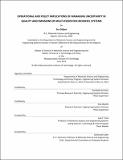Operational and policy implications of managing uncertainty in quality and emissions of multi-feedstock biodiesel systems
Author(s)
Gülșen, Ece
DownloadFull printable version (5.148Mb)
Other Contributors
Massachusetts Institute of Technology. Technology and Policy Program.
Advisor
Randolph Kirchain and Elsa Olivetti.
Terms of use
Metadata
Show full item recordAbstract
As an alternative transportation fuel to petrodiesel, biodiesel has been widely promoted within national energy portfolio targets across the world. Early estimations of low lifecycle greenhouse gas (GHG) emissions of biodiesel were one of the main drivers behind extensive government support in the form of financial incentives for the industry. However, several recent studies have reported a high degree of uncertainty and variation (U&V) in these emissions, raising questions concerning the carbon benefits of biodiesel compared to petrodiesel. A smaller degree of U&V in physical feedstock characteristics emerging from compositional variation was already known to producers. Although feedstock blending has been broadly practiced by the industry to meet multiple fuel quality standards and to control costs, its implications on these U&V characteristics of biodiesel have not been explicitly addressed by researchers or policymakers. This work investigates the impact of feedstock blending on the U&V characteristics of biodiesel by using a chance-constrained (CC) blend optimization method. The objective of the optimization is minimization of feedstock costs subject to fuel standards and the decision variables are feedstock proportions. Two sets of prediction models are developed to represent the physical properties and lifecycle emissions of feedstocks within the CC model. The results indicate that blending can be used to manage U&V characteristics of biodiesel, and to achieve cost reductions through feedstock diversification. Monte Carlo simulations suggest that emission control policies which restrict the use of certain feedstocks based on their GHG estimates, overlook blending practices and benefits, lowering the quality and increasing the cost of biodiesel. In contrast, emission control policies which recognize the multi-feedstock nature of biodiesel, provides producers with feedstock selection flexibility, and enables them to manage their blend portfolios cost effectively without compromising fuel quality or emissions reductions.
Description
Thesis (S.M.)--Massachusetts Institute of Technology, Dept. of Materials Science and Engineering; and, (S.M. in Technology and Policy)--Massachusetts Institute of Technology, Engineering Systems Division, Technology and Policy Program, 2012. Cataloged from PDF version of thesis. Includes bibliographical references (p. 169-177).
Date issued
2012Department
Massachusetts Institute of Technology. Department of Materials Science and Engineering; Massachusetts Institute of Technology. Engineering Systems Division; Technology and Policy ProgramPublisher
Massachusetts Institute of Technology
Keywords
Materials Science and Engineering., Engineering Systems Division., Technology and Policy Program.